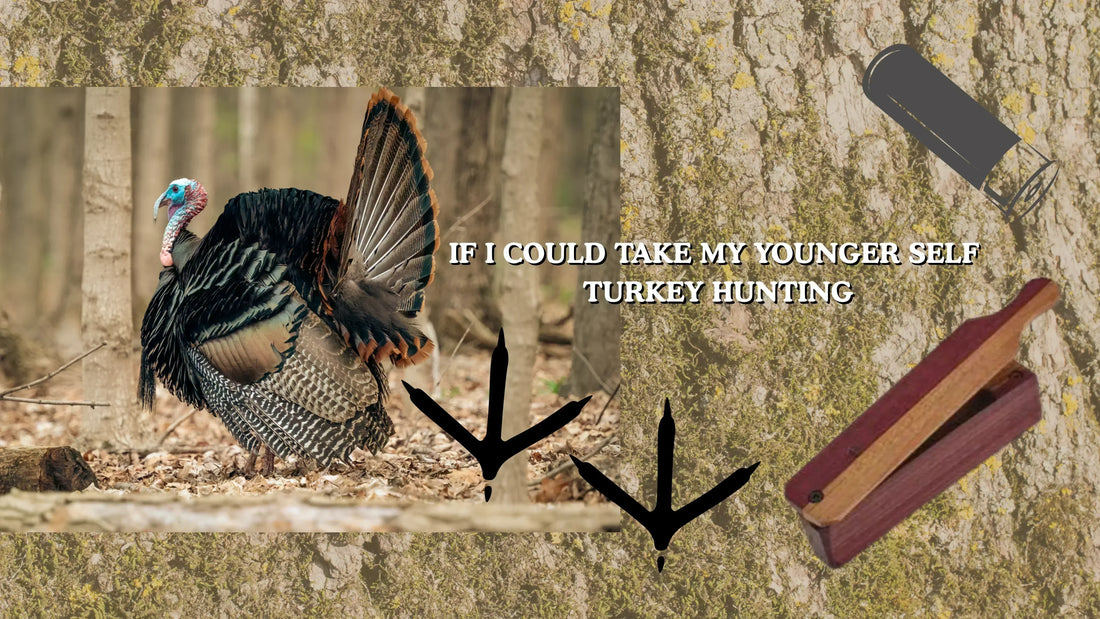
If I Could Take My Younger Self Turkey Hunting
Share
By Rex Meikle
I wouldn’t hesitate to take my younger self turkey hunting, although I think I’d talk too much about life lessons during the hunt. I didn’t grow up in a hunting family. My dad didn’t hunt, and no one showed me the ropes when it came to chasing toms. Everything I know about turkey hunting came from trial, error, and a whole lot of sitting on the ground and waiting. Looking back, there are a few key things I wish someone would’ve told me when I was first starting out. If I could take my younger self hunting, this is the advice I’d give—the kind of stuff that would have saved me time, frustration, and probably a couple missed birds.
Here are five lessons I wish I knew back then:
1. Pattern Your Gun Before the Season Starts
I learned this one the hard way. You might think your shotgun is good to go, but there’s really only one way to know. Shoot it! You need a tight, consistent pattern. If it shot well last year, that's great for last year - check it again.
Here’s how to do it:
- Set up a large target (at least 20" x 20")
- Make a 2" wide by 3" tall rectangle in the middle and shade it in with a sharpie (your turkey head)
- Set up about 20–25 yards away.
- Aim for the dead center and shoot (make sure you have a turkey load and turkey choke)
- Look at your target closely to see how the shot patterned
If the pattern is too wide or scattered, try a different turkey load. If it still is quite spread, try a different choke. Some guns can be picky about what ammunition and choke they like. Personally, I shoot my 20 gauge because it patterns way better than my 12 gauge. Learn how to pattern a shotgun for turkey hunting. Don’t wait until opening morning to figure this out. This step is crucial for success.
2. Scout Like It’s Half the Hunt (Because It Is)
There are two ways to hunt turkeys: you can chase them, or you can have them come to you. I prefer the second. But for that to work, you need to be set up close to where they already want to be. And to do that, you have to scout.
Some of the best scouting tools are:
- Trail cameras in areas with tracks or feathers
- Glassing field edges at sunrise or sunset
- Walking wood lines to look for sign (tracks, scat, feathers)
- Talking to farmers, landowners, or other hunters
- Locating roosting trees
In my experience, turkeys love corners of fields near woods. They like feeling safe where they have quick escape routes. These are the areas I’d recommend scouting. Scout up until you’re able to start hunting. Learn how to scout turkeys. If you see a big tom in a field the evening before your season starts I’d strongly recommend hunting there in the morning.
3. Wake Up Earlier Than You Think
One of the most common mistakes new turkey hunters make is not getting out early enough. If you're not settled and still by first light, you’re already behind. Turkeys are early risers. When the woods start to wake up—songbirds singing, owls fading out, deer moving—you want to be in position, quiet, and ready. This is when you’ll hear the first gobbles. These gobbles tell you exactly where the toms are at. If none are close to you, now is your time to head closer to where you hear them.
It’s easier than ever to figure out when it's first light. If you have an iPhone, just open the Apple Weather app, scroll down and click "Sunrise," and you’ll see the exact time for first light. Give yourself time to walk in, set up, and let the woods settle back down before everything kicks off. I know it’s hard waking up in the morning, but 5 early to the blind is better than 5 minutes late.
4. Call Very Little in the Morning
When you're just starting out, it's very tempting to call a lot—especially when you get a gobble in return. However, the best advice I can give is to call very little early in the morning.
Wait until you hear the first gobbles before making any sounds. When you do call, keep it soft and simple—just a few clucks or a yelp (if you have no idea what I’m talking about - turkey calling basics). If you get a response, stop calling. Turkeys are incredible at pinpointing exactly where a sound comes from, and overcalling can spook them if your call sounds even slightly off.
That gobble is confirmation: the tom knows where you are. Even if he doesn’t show up right away, stay put. I recommend staying in that spot until at least 10 AM—he might swing by late morning to check out the spot where he heard you at sunrise.
If you absolutely feel like you need to call again after that initial response, limit it to once every 30 minutes or so. And if you have birds in the field but they’re hanging up and not coming in, use soft purrs and light yelps to keep their interest—but don’t overdo it. Let the silence build curiosity. Learn more about calling Turkeys.
5. Aim Where the Neck Meets the Body
Most people say to aim for the head. Technically, they’re not wrong—but the head is small and easy to miss. Instead, aim for the base of the neck. This gives you a much lower margin for error.
- If you hit dead-on, you drop the bird.
- If you shoot a little high? Still good.
- A bit left or right? Still a strong chance of a clean kill.
It’s a small adjustment that makes a big difference, especially when you finally get that bird in range after sitting for hours.

If you’re just getting into turkey hunting, I hope this helps you skip some of the hard lessons I had to learn myself. There’s something incredibly rewarding about figuring it out on your own, but a little guidance can go a long way.
Good luck out there. Hunt safe, respect the land, and enjoy every second in the woods—even the quiet ones. Oh yeah, and try to help the next generation once you get dialed in.



